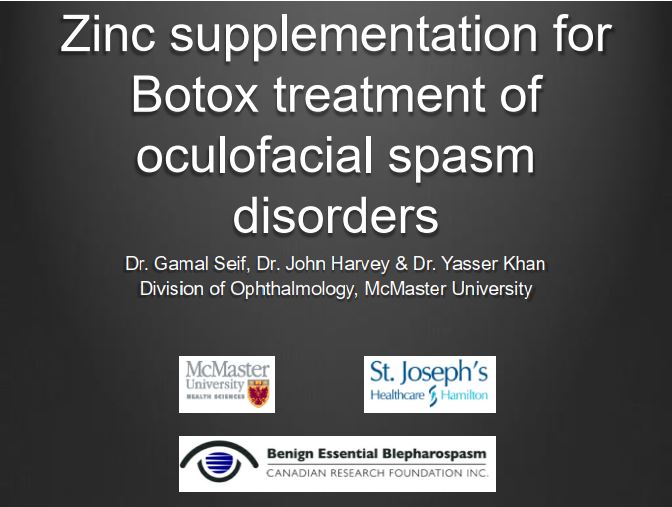BEBCRF Support Group Meeting – Toronto, Summer 2016
Zinc Supplementation for Botox treatment of oculofacial spasm disorders
Presenter:
Dr. Gamal Seif
Contents:
Dr. Seif's Presentation
This study examined the use of zinc supplementation for patients who are being treated with botulinum toxin for either benign essential blepharospasm (BEB) or hemifacial spasm (HFS). Botulinum toxin has been used for many years to treat BEB and HFS with variable results. This study aims to assess if this variability is due to the variability of zinc within individual patients.
We know that zinc, as an element, is a ‘cofactor’, which means that it is something that botulinum toxin needs in order to work effectively. They have done a good deal of basic research where they stripped the zinc off the botulinum toxin and they noted that the toxin did not work as well without the zinc.
This study was presented at the American Society of Ophthalmic and Reconstructive Surgery annual meeting in November 2015.
You can see a detailed synopsis of Dr. Seif's presentation in PDF form here:
BEB_Newsletter_August_2016.pdf
BEB – A Synopsis
Blepharospasm isn't really very different from other sight problems, apart from the fact that sometimes you can see fine - and then at others you're blind. The big problem is with getting it diagnosed in the first place.
Yet in some ways blepharospasm is, in fact, quite different from most other vision disorders: because it affects the sight without actually damaging the vision. The entire structure of the eye - including the optic nerves, and the areas of the brain connected with sight - remain undamaged; and at the same time quite a lot of people with the condition are 'functionally blind' because they literally cannot keep their eyes open for long.
Blepharospasm is a form of "dystonia" - a movement disorder that results in uncontrollable (and sometimes painful) muscle spasms. It is a neurological (brain-based) disorder, because the brain is sending the muscles faulty messages.
Some dystonias affect multiple areas, especially the back and the torso, causing the person to jerk and twist uncontrollably. These usually start in childhood, and spread across the rest of the body. Adult dystonias tend to be confined to a "focal" area like the neck, the hand or the mouth. Blepharospasm, the type that affects the muscles around the eyes, usually starts relatively late in life, after the age of 50. It is more common in women than men.
Typically, it may begin with an uncomfortable gritty feeling in the eye and then moves on to excessive blinking; and from there, it can get to the point where the person cannot open their eyes much at all. In most people, it doesn't do anything else and it doesn't spread, although about 20 per cent of people who develop it in this way will also, over time, develop some other muscle spasms to affect the jaw or the head and neck. Many people also find that their symptoms - including their discomfort - gets a lot worse in bright and/or flickering lights.
There's good reason to think that dystonia arises from a problem in the basal ganglia, in the centre of the brain. All messages pass through this part of the brain; it's like a relay or integration unit for sensory information, motor information, motivational information and so on, and it plays a very important role in integrating this information and getting the correct messages out to the nerves. There is a very fundamental process in the brain called 'brain plasticity', which is effectively the mechanism whereby we learn in how to respond to stimuli. It is thought that in dystonia this process is overactive (perhaps triggered by a malfunction in the basal ganglia) and this can lead to 'learning' errors in some of the programs that control movement. So that sore gritty feeling in the eyes might set off overactive blinking and this triggers an abnormal learned pattern of movement in the muscles around the eyes which is produced all the time.
There appears to be a genetic link as well. BEB often runs in families, and researchers have been investigating the gene connections. So far one gene responsible for early-onset dystonia has been established since 1997.


